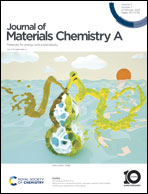Piezoelectricity of strain-induced overall water splitting of Ni(OH)2/MoS2 heterostructure†
Abstract
In this study, we synthesized several active sites of molybdenum disulfide (MoS2) nanoflowers (NFs) decorated with Ni(OH)2 nanoparticles (NPs) to form heterostructures. Our results revealed that Ni(OH)2/MoS2 NF heterostructures caused the splitting of water into hydrogen (H2) and oxygen (O2) gas. The Ni(OH)2/MoS2 NF interface exhibited strain-induced piezoelectric potential (piezopotential) that promoted charge separation, reducing the kinetic barrier in the water splitting process and promoting the hydrogen evolution reaction (HER) and the oxygen evolution reaction (OER). In high-resolution transmission microscopy images, the measured lattice fringe d spacing was approximately 0.67 nm, which was higher than the reported value. The calculated tensile strain of Ni(OH)2/MoS2 NF heterostructures was approximately 3.5%. The findings based on density-functional theory and using the finite element method indicated that the interfacial piezopotential generated between Ni(OH)2 and MoS2 NFs enhanced charge transfer and electrochemical reactions. To obtain a current density up to 10 mA cm−2, we set the overpotential and Tafel slope of Ni(OH)2/MoS2 NF heterostructures at 155 mV and 62.1 mV dec−1 for the HER and 328 mV and 69.3 mV dec−1 for the OER, respectively. Moreover, a high Faraday efficiency (84.1%) was observed over 48 h, with no significant decline in the HER and OER.



 Please wait while we load your content...
Please wait while we load your content...